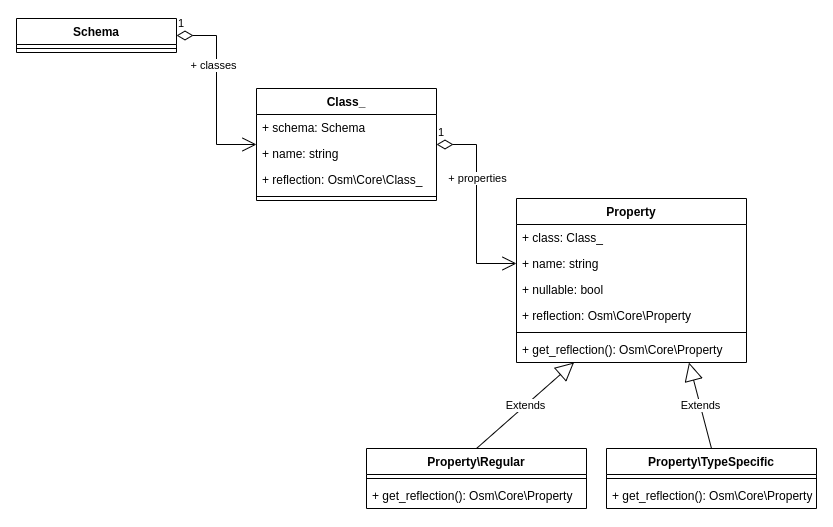Osm Admin: Schema Hydration
2 years ago ∙ 3 minutes read
I developed dehydrate()/hydrate() functions for a very practical need - storing the data class schema:
- in cache - to reduce processing time spent on reflection;
- and in database - to compare current and new database schema, and only add new tables and columns.
This article describes the information stored in the schema, and unit tests that I prepared in order to be sure that schema classes are property hydrated.
Contents:
What's In Schema, Anyway?
For now, let's focus on the primary aspect of the data schema, that is information about data classes. There is a lot more information - about underlying database tables that store data objects, about grids and forms UI components that allow viewing and editing data objects - but I'll return to that later.
Let's begin with some example. In an e-commerce application, there are products of different types: bags, dresses, and others. For more information about subclasses, see Subclasses.
The Product data class specifies the common product properties while Bag and Dress subclasses specify type-specific properties:
use Osm\Core\Traits\SubTypes;
use Osm\Core\Attributes\Type;
use Osm\Admin\Base\Attributes\Storage;
...
/**
* @property string $sku #[Serialized]
* @property string $description #[Serialized]
*/
#[Storage\Table('products')]
class Product extends Object_
{
use Id, SubTypes;
}
/**
* @property string $color #[Serialized]
*/
#[Type('bag')]
class Bag extends Product {
}
/**
* @property string $color #[Serialized]
* @property string $size #[Serialized]
*/
#[Type('dress')]
class Dress extends Product {
} Schema collects all classes marked with a #[Storage\*] attribute, their subclasses, and all the classes used as their property types, recursively.
In addition, all type-specific properties are collected into the definition of the base class.
Schema Classes
The following diagram shows the data structure that contains the collected information about data classes:

As you see, the Schema object contains an array of Class_ objects for each collected class, and each Class_ object contains an array of serialized properties, each being an instance either of Property\Regular class - if it's a base class property, or Property\TypeSpecific class - if it's a property of a subclass.
Unit Tests
In the test_01_schema_hydration.php file, There are two unit tests: one tests dehydration/hydration process, the other one - native PHP serialization/un-serialization process. Hydration is used to store objects in the database and send/receive them over HTTP. Serialization is used to store objects in cache:
public function test_hydration() {
// GIVEN a schema reflected from PHP classes
$schema = $this->app->schema;
// WHEN you dehydrate it and then hydrate it back again
$dehydrated = dehydrate($schema);
$hydrated = hydrate(Schema::class, $dehydrated);
// THEN it's the exact copy of the original schema
$this->assertSchemaHydrated($schema, $hydrated);
}
public function test_serialization() {
// GIVEN a schema reflected from PHP classes
$schema = $this->app->schema;
// WHEN you serialize it and then unserialize it back again
$serialized = serialize($schema);
$unserialized = unserialize($serialized);
// THEN it's the exact copy of the original schema
$this->assertSchemaHydrated($schema, $unserialized);
}In both cases, the successful recovery of the schema object is verified using assertSchemaHydrated() method. For each class, this method calls assertClassHydrated() method, which, in turn, for each property class assertPropertyHydrated() method.
Testing Subclasses
One thing to check is hydration of subclasses. If a property is of a Property\Regular class, then it should be hydrated back as Property\Regular. If it doesn't, then either the base class isn't using the SubTypes trait, or the subclasses don't use #[Type] attribute:
class Property extends Object_
{
use SubTypes;
...
}
#[Type('regular')]
class Property\Regular extends Property
{
...
}Here is how it's verified:
protected function assertPropertyHydrated(Property $original,
Property $hydrated, Schema $hydratedSchema): void
{
$this->assertTrue($original::class === $hydrated::class);
...
}Testing Parent References
The other easy-to-miss thing is parent references. Each class object is assigned a reference to its parent schema object, and each property object is assigned a reference to its parent class object. In order to avoid having circular references, the parent references are not dehydrated, and after hydration they should be manually restored in the __wakeup() method:
/**
* @property Class_[] $classes #[Serialized]
*/
class Schema extends Object_
{
...
public function __wakeup(): void {
foreach ($this->classes as $class) {
$class->schema = $this;
}
}
}
/**
* @property Property[] $properties #[Serialized]
* ...
*/
class Class_ extends Object_
{
...
public function __wakeup(): void
{
foreach ($this->properties as $property) {
$property->class = $this;
}
}
}Here is how it's verified:
protected function assertClassHydrated(Class_ $original,
Class_ $hydrated, Schema $hydratedSchema): void
{
$this->assertTrue($hydrated->schema === $hydratedSchema);
...
}
protected function assertPropertyHydrated(Property $original,
Property $hydrated, Schema $hydratedSchema): void
{
$this->assertTrue($hydrated->class ===
$hydratedSchema->classes[$hydrated->class->name]);
...
}Testing Other Data
The rest assertions check that all the data is properly restored. Some data is #[Serialized] into the dehydrated state as is, other is computed from the serialized data.

